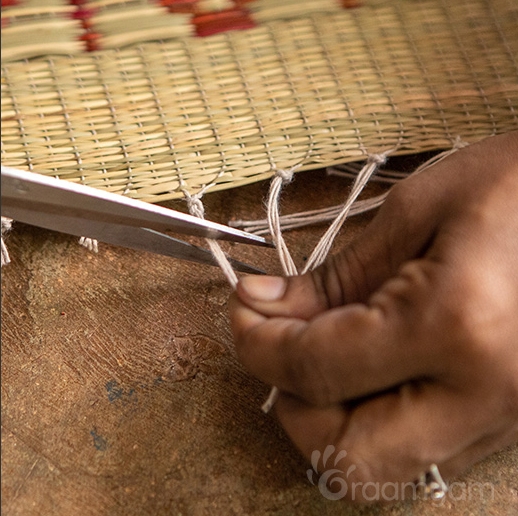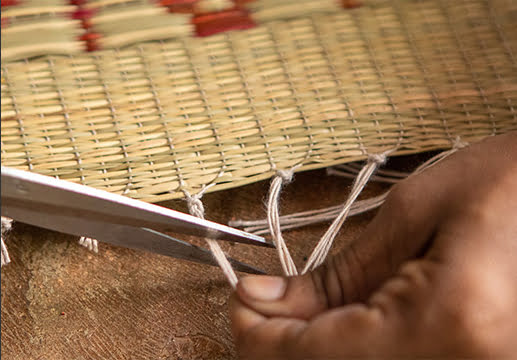Killimangalam Mat Weavers
It is a Journey of Hearts and Minds…

Tradition
Our journey in search of the mat weaving community took us to a tiled roof building at a sleepy corner of Killimangalam. That was Killimangalam Pulpaaya Neythu Co-operative Society, founded in 1977, to revive “Pulpaaya Weaving” (kora grass mat weaving), the traditional occupation of the Kurava community residing in the region.
When we reached the location, we came to know that the 40-year-old society has now been reduced to a five-member team of passionate weavers, Beena, Sheeja, Bindhu, Sindhu, and Sudhakaran – the secretary of the organization.
On our visit to their weaving unit, we found Beena being busy with crafting a beautiful mat with an intricate blue and beige pattern. We were mesmerized by the harmonious way her imaginative mind and dexterous fingers worked, rewarding the weaving process a meditative nature altogether
“As a craft, weaving patterns on grass mats demands great presence of mind and mental sharpness. We don’t sketch motifs beforehand. The warp will be a blank canvas where we will create the design, strand by strand, without using any tools or devices. If we miss a step or make a mistake, we might have to redo the entire mat,” said Beena.
And that was enough for us to recognize their unwavering devotion to the craft!
Natural
“With proper maintenance, the mats last for over 30 years”
We were getting more and more intrigued about the craft and went on collecting more details on its making. We came to know that the renowned Killimagalam mats are woven using ‘kora grass’ – locally known as ‘muthanga pullu’ – grown wild by the banks of tranquil Nila river (Bharathappuzha). The mats are well known for the superior quality of their weave and are easily distinguishable from grass mats produced in other regions, with their unique finesse, durability, and aesthetic appeal.
“With proper maintenance, the mats last for over 30 years”, Sudhakaran, the secretary of the society told us.
Due to competition from machine-made grass mats and plastic mats, the weavers of Killimangalam are finding it difficult today to create a market space for them that values the craft and pays a fair price for this natural product. In spite of these obstacles, this group of women continues to invest their time and effort in weaving.
It was pitiful to see the maintenance and repair of the building, that houses the unit, being stalled due to the lack of sufficient funds. Even so, it was kept neat and functional. The passion and the enthusiasm of those weavers were like rays of hope shining through the cracks…

Handmade
Most of these weavers are homemakers who discovered a newly-found interest through the Co-operative Society and took the trouble to learn this physically and creatively demanding job. Their gifted hands working on the looms are the primary reason why the valuable cultural heritage of the Kurava weavers continues to stay alive.
On a deliberate search for its history, we found out that the Kurava community migrated to Killimangalam from certain regions of Tamil Nadu. Perhaps, the availability of superior quality kora grass in the river banks encouraged them to settle in this serene village.
Folklore has it that the early migrants wove a grass mat and presented it to the ruler of Cochin; the king, who was fascinated by their skills, gifted them the land they were residing. Gradually, over the years, a weavers’ community got established there.
At present, Ayyappan is the only master weaver in the community. Prabhavathi Teacher, the person who trained the current group of weavers, is also a name to be mentioned, for the vital contributions she made in introducing women from the locality to the craft making.

Gifted Hands
Making a fine 200 count pulpaaya usually takes
Pleased witnessing the unassuming hard work and perseverance of these people, we enquired about the duration of creating this perfect craft, and the answer of the team was, “making a fine 200 count pulpaaya usually takes 10 to 15 days” – yes, it was as strenuous as that!As we were documenting the finishing steps of making the mat, we saw Sheeja tying a bright red thread in the corner of the mat. “This is the final step. A little something to help us identify mats woven by our society,” she said.The lone scarlet stood out from the tufts of white at the edge. It felt like a metaphor for their vibrant and gritty spirits and a mark of their commitment to this craft…If you are interested in the details of mat making process, we have it here.
Featured Products
View AllMat Making Process
We stayed with the weavers from the beginning to the end of mat making process to get a detailed understanding of the organic process of creating this artistic testament…


The paavu or starched cotton thread comes from the spinning mills in bundles. The elders of the weaving family would separate and straighten out the threads, each of which would have a length of about 44 meters. The separated thread is then tied onto the piece of thread remaining from the preceding warp on ‘maduppu’. This process, which is termed as ‘ponakkal’, is not familiar to all weavers. Preman told that in their family, only his mother knows this well. Once all the warp threads and the 44 meters threads are tied and wound respectively on to the ‘maduppu’, it is mounted on to the loom.

Next is the intricate Jacquard or ‘putta’ design setup, where the weaver takes each warp thread through multiple controlling threads that arise from the jacquard device. This determines the number of designs that will be woven into the width of a saree. The threads (either golden, silver, or normal cotton coloured) to be used for designs are wound on small bobbins, called ‘nadavu’. So, with ‘maduppu’ setup and the warp threads taken through the jacquard setup and tied to the weaving side of the loom, Preman was ready to start showing us the weaving process.




